Birds
Media

Species Types
Scientific Name
Setophaga castanea (formerly Dendroica castanea)
Description
The male bay-breasted warbler is easy to identify, while females and nonbreeding males present a challenge. This species migrates through Missouri in spring and fall.
Media

Species Types
Scientific Name
Icterus spurius
Description
The orchard oriole is a common summer resident in Missouri. Males are rusty and black; females are olive green and yellowish. Look for them high in trees in places with scattered trees, especially near water.
Media
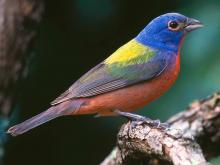
Species Types
Scientific Name
Passerina ciris
Description
The male painted bunting is one of the most colorful birds in North America, with its blue head, red underparts, and green back. Look for it in tangles and thickets in the southwest part of our state.
Media
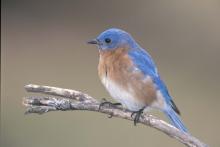
Species Types
Scientific Name
Sialia sialis
Description
The eastern bluebird is the state bird of Missouri. Many say its song sounds like “Cheer cheerful charmer.” The male has blue upperparts and rusty and white underparts.
Media

Species Types
Scientific Name
Hylocichla mustelina
Description
This is the melodious “bell bird” of Missouri forests. Though this relative of the American robin and eastern bluebird might be hard to locate, its flutelike voice decorates the sound of woodlands the way wildflowers decorate the forest floor.
Media
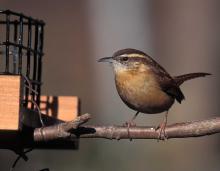
Species Types
Scientific Name
Thryothorus ludovicianus
Description
Male Carolina wrens sing a loud “teakettle, teakettle, teakettle.” This species is a rich reddish brown with white throat and eyebrow. Pairs hunt furtively in brushy tangles, tails cocked upward.
Media
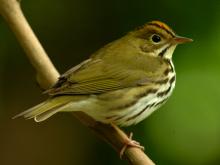
Species Types
Scientific Name
Seiurus aurocapilla
Description
Ovenbirds sing a clear, ringing "TEACHer-TEACHer-TEACHer-TEACHer" that gets progressively louder. A common migrant, it forages among leaves on the forest floor.
Media
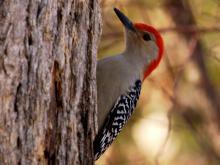
Species Types
Scientific Name
Melanerpes carolinus
Description
A striking woodpecker with grayish white face and underparts, black-and-white banded upperparts, and a red band on the head or nape. The red belly is often not noticeable.
Media
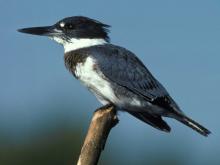
Species Types
Scientific Name
Megaceryle alcyon (formerly Ceryle alcyon)
Description
Belted kingfishers have a big head with a shaggy crest, a long, sharp bill, and a short tail. They perch or hover along rivers and shores, then plunge in to catch fish. The call is a loud rattle.
Media
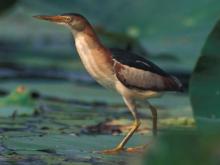
Species Types
Scientific Name
Ixobrychus exilis
Description
One of the smallest herons in the world, the least bittern is about as big as a pigeon. It’s nearly impossible to locate when it hides in a cattail marsh. Most see it only in flight.
See Also







Media

Species Types
Scientific Name
Hemaris diffinis
Description
The snowberry clearwing is a moth that confuses people because it looks like a bumblebee and flies like a hummingbird!
Media

Species Types
Scientific Name
Hyles lineata
Description
The white-lined sphinx moth sometimes confuses people because it flies, hovers, and eats from flowers like a hummingbird. The adults often fly during daylight hours as well as in the night and are often found at lights.
Media

Species Types
Scientific Name
Darapsa myron
Description
The Virginia creeper sphinx moth is common in woods and brushy areas and comes to lights at night. The larvae eat Virginia creeper and grape leaves.
Media

Species Types
Scientific Name
Perimyotis subflavus (formerly Pipistrellus subflavus)
Description
Tri-colored bats, formerly called eastern pipistrelles, are relatively small and look pale yellowish or pale reddish brown. The main hairs are dark gray at the base, broadly banded with yellowish brown, and tipped with dark brown.
Media

Species Types
Scientific Name
Myotis grisescens
Description
Gray myotises are difficult to distinguish from other mouse-eared bats. A key identifying feature of the gray myotis is that its wing is attached to the ankle and not at the base of the toes. It’s an endangered species.
Media

Species Types
Scientific Name
Myotis lucifugus
Description
The little brown myotis (little brown bat) is one of our most common bats, but populations are declining. White-nose syndrome has taken a heavy toll in northeastern states. This species is now listed as vulnerable across its range.
Media

Species Types
Scientific Name
Myotis sodalis
Description
The Indiana myotis, or Indiana bat, summers along streams and rivers in north Missouri, raising its young under the bark of certain trees. It is an endangered species.
About Birds in Missouri
About 350 species of birds are likely to be seen in Missouri, though nearly 400 have been recorded within our borders. Most people know a bird when they see one — it has feathers, wings, and a bill. Birds are warm-blooded, and most species can fly. Many migrate hundreds or thousands of miles. Birds lay hard-shelled eggs (often in a nest), and the parents care for the young. Many communicate with songs and calls.





















